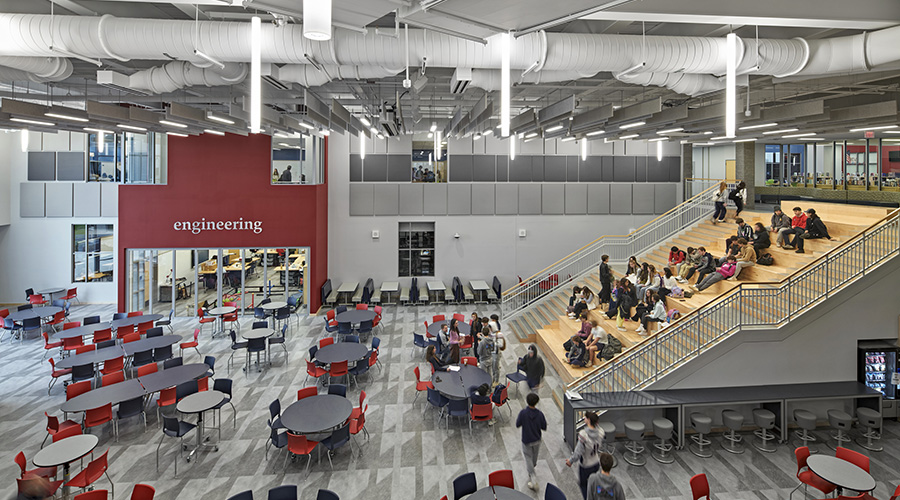Education Facilities Managers Work to Fight the Great Resignation
As staffing struggles persist, maintenance and engineering managers seek answers to expand the workforce.
By Mackenna Moralez, Associate Editor
To put it mildly, the last three years have not been easy for maintenance and engineering managers in education facilities. Between budget cuts, navigating the ongoing COVID-19 pandemic and struggling to find and retain technicians during the labor shortage, managers are operating colleges and universities the best they can with limited resources.
Beyond these challenges, mounting impatience among students, faculty and staff, coupled with rising maintenance requests, have prompted some managers to leave the profession. Building occupants and visitors often are unaware of all the tasks managers have to juggle every day. To meet these challenges requires flexibility. It is up to the managers to handle whatever is thrown at them.
“Our schedules are based upon student, staff and faculty needs,” says Michael Hofmann, director of utilities and technical support for the University of Cincinnati. “During times students are not in class – spring, winter, and summer breaks, for example — we schedule as much maintenance as possible so as not to interrupt classes or the student experience. As such, we must work weekends, nights and at times around the clock to complete maintenance in very small windows of opportunity.”
Staffing challenges only complicate the challenge of having limited time to perform routine but critical maintenance. Managers have to prioritize technicians’ activities, and not everyone is happy with the decisions. Hofmann says some people assume maintenance and engineering departments have unlimited budgets, but that is not true.
Deferred maintenance and delayed capital projects have become a major challenge for managers because their departments must inspect, repair and maintain aging systems and buildings, and there is rarely enough funding to perform all of the required repairs and upgrades to ensure the safety and reliability. That concern only grows when the challenge involves a large stock of facilities.
“Managing the wants and needs of over 100 buildings on campus and as many as 30,000 occupants in these buildings is challenging,” Hofmann says. “Every building is different, and every occupant is different, so balancing the needs of everyone can be hard. Regardless of maintenance staff size, all work cannot be done immediately and must be prioritized. For example, emergency maintenance takes the highest priority.
“We are currently seeing a rash of pipe bursts due to a severe cold snap. Managing the students, faculty and staff needs while keeping water flowing while not interrupting class has proven to be difficult.”
Managers in higher education touch every stakeholder on campus, whether it is through the work their departments or the buildings they maintain. Not everyone on campus is going to like the spaces they work, study and live in, but it is the managers’ job to help improve the condition of these spaces enough so people feel connected to it. Managers also need to be patient with front-line technicians performing the maintenance tasks and give them enough time so they can make the proper fixes, rather than rushing through it and needing to repeat the job.
Exposing secrets
Maintenance and engineering management remains one of the best kept secrets on university campuses. Not many people know or understand what departments actually do, and many more do not realize that it is a career option – and a fulfilling one, at that. By communicating throughout campuses and communities, managers stand a better chance of raising interest in their departments as sources of employment.
“One of the challenges they have right now is recruiting and retaining staff,” says Lander Medlin, resident and CEO of APPA, an association of education facilities professionals. “They are competing with jobs like Costco and McDonald’s that are starting to pay above minimum wage. One of the ways that education facilities management could do better is by identifying all the benefits that come from a particular hourly wage. That way if they can show the wage rate and how it’s calculated and highlighted, (managers) can really demonstrate a total compensation package.”
To help retain newly hired technicians, some colleges and universities have improved their onboarding processes so new hires know exactly what they are getting into. This process allows managers to create an environment that people will want to work in instead of quitting when things become too overwhelming.
The Great Resignation has affected the way people view their jobs. Being intentional with upskilling and reskilling within the trades allows for professional development that technicians might not have received beforehand. Having these skills allows crew members to not only grow their careers, but it also gives them a voice in the ideas they help generate.
“Many times, people come into facilities management from construction jobs where they work maybe six months out of the entire year, so there’s some job security associated with this because they’re always going to be utilized,” Medlin says. “In colleges and universities, we are able to use (new hires) all year long. Being used more broadly allows for potential promotability, giving people other areas to build around a career, and that’s really important.”
Hofmann says that encouraging students to be involved in maintenance and engineering management at a young age also can help expand the workforce. Apprenticeship programs allow people to get on-the-job training and formal education at a young age.
“There’s four major responsibility areas that cut across facilities management as a profession: construction; operations and maintenance; energy and utilities; and general administration of finance,” Medlin says. “It’s technical, but it’s also general. There’s never a day that you don’t learn something new and different, and that is just too cool. Facilities management is the best-kept secret, and they can grow so much. It’s a very complicated profession, but it’s truly an exciting career for people to be involved in.”
Managers play a critical role in the success of students earning their degrees. Sitting in a building that is too hot or too cold can greatly affect someone’s learning. Hearing these types of complaints actually allows managers to optimize buildings so connections can be made among students, staff and faculty. Learning is not just limited to classrooms. Intentionally creating spaces for students to connect, collect and learn enhances the learning environment.
“Our buildings provide a place to learn or not,” Medlin says. “If we create environments of belonging, of welcoming of inviting environments both spaces and places, and also, as we work with one another, it will make a huge difference in people wanting to come to these campuses, wanting to be part of this profession and wanting to be part of this community.”
Mackenna Moralez is the associate editor for the facilities market.
Related Topics:












